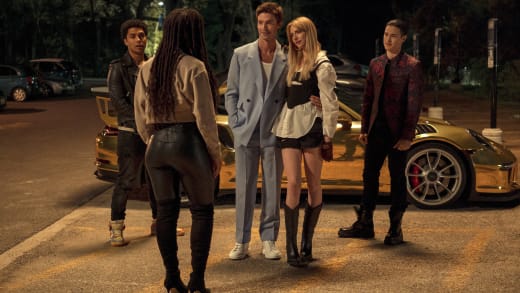Louisa Hall’s novel Reproduction centers on a writing professor who struggles to conceive, give birth to, and then parent a young daughter all while attempting to write a “biographical novel” about Mary Shelley, the author of Frankenstein. Hall’s unnamed protagonist, who is also the novel’s narrator, is teaching a course on science fiction and re-reading Frankenstein, and soon, the course and the book begin to seep into her everyday life, which takes on an otherworldly strangeness. When she suffers a miscarriage, she feels as if she is “floating in the coldness of space”; her hospital visit for a D&C, performed by masked doctors in a cold, bare room—like “a capsule sent into space”—is surreal and disorienting.
Set in our recent American past, and spanning the years of the pandemic, the novel’s present feels uniquely fraught: Reproductive rights are under fresh attack with the fall of Roe, mass shootings spur fear and panic, and climate change brings floods and fire to the West Coast (sparked, literally, by a gender reveal party). And so the narrator reaches to the past, searching for comfort and literary sisterhood. In Mary Shelley, she finds a muse and a kindred spirit, a woman whose biography lines up with her own and whose writing provides a touchstone for theorizing the pain of motherhood, grief, and creativity. The narrator recounts, for example, how Shelley began writing Frankenstein, a “ghost story” about the reanimation of corpses, on the shores of Lake Geneva in 1816, under a dark cloud from a volcanic eruption, after suffering the loss of her own newborn baby. The narrative details of Shelley’s life take up a good chunk of Reproduction’s first section, with Shelley’s voice, from snippets of her journal entries and other writings, including Frankenstein’s preface, interwoven with the narrator’s own.






 By emphasizing the connections between Shelley’s experience and a contemporary story of pregnancy and pregnancy loss, Hall’s novel figures the work of reproduction as, paradoxically, both isolating and common. This is not a story that hasn’t been told; Hall is mindful of her novel’s place in literary history and our current moment. In addition to joining a spate of contemporary twists on Frankenstein, such as Jeanette Winterson’s Frankissstein (2019), Reproduction also appears among a recent burst of what we might call “maternity literature,” including Maggie Nelson’s The Argonauts (2015), Rivka Galchen’s Little Labors (2016), Sheila Heti’s Motherhood (2018), Lucy Knisley’s Kid Gloves (2019), Szilvia Molnar’s The Nursery (2023), and Olga Ravn’s My Work (2023). (Glance at the excellent syllabus called “Writing Motherhood” that Maggie Doherty put together over at Bookforum for a curated list.) At the center of this spate of books about motherly ambivalence and struggle is the fraught relationship between motherhood and writing, with each author arriving at a unique conclusion about how the two might coexist.
By emphasizing the connections between Shelley’s experience and a contemporary story of pregnancy and pregnancy loss, Hall’s novel figures the work of reproduction as, paradoxically, both isolating and common. This is not a story that hasn’t been told; Hall is mindful of her novel’s place in literary history and our current moment. In addition to joining a spate of contemporary twists on Frankenstein, such as Jeanette Winterson’s Frankissstein (2019), Reproduction also appears among a recent burst of what we might call “maternity literature,” including Maggie Nelson’s The Argonauts (2015), Rivka Galchen’s Little Labors (2016), Sheila Heti’s Motherhood (2018), Lucy Knisley’s Kid Gloves (2019), Szilvia Molnar’s The Nursery (2023), and Olga Ravn’s My Work (2023). (Glance at the excellent syllabus called “Writing Motherhood” that Maggie Doherty put together over at Bookforum for a curated list.) At the center of this spate of books about motherly ambivalence and struggle is the fraught relationship between motherhood and writing, with each author arriving at a unique conclusion about how the two might coexist.
Take, for example, Molnar’s The Nursery, which brutally depicts the solitary horror of postpartum days and nights as if to redress a gap in the literary record. “Has there ever been a description in literature of what it entails to change an infant’s diaper?” Molar’s translator-protagonist wonders. The answer, of course, is yes (Sylvia Plath’s “stink of fat and baby crap” jumps to mind), but one senses the moral force and righteous indignation behind the question. After all, how does one represent the mix of joy, stress, exhaustion, and mindless repetition that characterizes caring for a newborn? How might a writer pound this into a coherent narrative, with a beginning, middle, and end? For Molnar’s translator, “the horror of mundanity” is something foreign for which she cannot find “the appropriate translation.”
 Hall’s narrator in Reproduction joins other mother-writers such as Molnar’s who task themselves with representing an experience that is, by nature, difficult to describe. But for Hall’s narrator, the problem is not that stories about reproduction haven’t been told—it’s that they have. Hall’s narrator figures herself an explorer, like Walton, the sea captain in Frankenstein, who tells the chilling tale through letters—but she knows she is not the first to chart this course. And it is still lonely. Even the comparison between pregnancy and exploration is not new—Shelley modeled it, writing science fiction herself, with Frankenstein and also her final book, The Last Man. For Hall, the trouble is not so much that writers can’t find the words to describe their reproductive experiences but that their stories will always be, in some way, inadequate, inscrutable.
Hall’s narrator in Reproduction joins other mother-writers such as Molnar’s who task themselves with representing an experience that is, by nature, difficult to describe. But for Hall’s narrator, the problem is not that stories about reproduction haven’t been told—it’s that they have. Hall’s narrator figures herself an explorer, like Walton, the sea captain in Frankenstein, who tells the chilling tale through letters—but she knows she is not the first to chart this course. And it is still lonely. Even the comparison between pregnancy and exploration is not new—Shelley modeled it, writing science fiction herself, with Frankenstein and also her final book, The Last Man. For Hall, the trouble is not so much that writers can’t find the words to describe their reproductive experiences but that their stories will always be, in some way, inadequate, inscrutable.
One challenge is that one doesn’t ever know how the stories one is surrounded by will or will not apply to them—or how one’s own will end. To Hall’s credit, the novel’s sections allow for chronicling more experiences than just one: At least four pregnancies unfold in the book, with different outcomes and in different circumstances. If pregnancy stories abound, the problem is figuring out how one fits into the stories, how to relate to them, what each one can illuminate or distort.
There is the inconvenient fact that the pain of labor—which pregnant people hear so much about—defies storytelling. The narrator’s birth story is at the core of the book, and much of it revolves around the problem of describing pain. The narrator has been told by female relatives that she can withstand a “natural” birth, even that it’s in her blood, but when the contractions begin, she is disarmed by the pain, dismissed by the nurse line, and, perhaps most upsettingly, left to suffer alone. Reflecting on the experience, she turns to the famous philosopher of pain, Elaine Scarry, to get at its elusive quality. Pain is characterized “by its refusal to be expressed,” she explains; once it is expressed, it is no longer pain but something else. In the moment, she feels like an abandoned animal. All the stories she heard, meant to be empowering, were not. They ultimately made her feel more alone.
Hall excels, however, at describing the solitude and isolation of pregnancy and postpartum. Her narrator compares her early postpartum days to a lunar voyage—a description that felt to me exactly right, both poetic and true. Having given birth to a strange new creature, in the silence and darkness of the hospital, the narrator and her husband seem to exist all alone, on a new, unexplored planet. “Did it all really happen?” she wonders. “It must have happened on the moon.” Here, Hall’s narrator again takes her cue from Shelley’s explorer, Walton, to convey the disorientation and strangeness of new motherhood. (There is also a nice etymological connection between the “lunar” and “lunacy,” too.)
The novel enters new and more fraught territory in its third section, which focuses on the pregnancy journey of the narrator’s former friend, Anna. Anna is undergoing IVF, and she, like our narrator, is obsessed with Frankenstein, so Shelley’s novel remains a key intertext. Anna is also a scientist who has worked on genetic engineering throughout her career; our narrator describes her as “a woman Frankenstein of the twenty-first century.”
Given the novel’s thoughtful probing of the stories we tell ourselves about reproduction, I was surprised that the IVF storyline is, in many ways, stereotypical. From the start, the ethics of Anna’s choice are a subject of bioethical debate. What’s “natural” preoccupies Anna, and she defensively argues that, in a world with antibiotic-raised chickens, there is no such thing as a “natural” pregnancy. IVF is associated from the start, too, with failed heterosexuality. As the narrator recounts, Anna’s longest romantic relationship was an abusive “experiment” in which she created her own monster. She has now run out of reproductive time and is taking matters into her own hands, going through multiple egg retrievals and then an embryo transfer of her own devising.
At the same time, our narrator discovers she is pregnant again, and is wary to share the news with Anna after losing her previous pregnancy. The subtle competition and distrust between these former friends is uncomfortable—and realistic. They say the wrong things; they judge and misjudge each other. For me, the struggle of this relationship threw the narrator’s imagined relationship with Mary Shelley into relief: That was a story, fixed in history, with an ending—and isn’t it easier to connect with someone whose story is already over, stable, and ever ready for our own interpretations of it?
In the end, Hall offers a final gesture of female friendship that I found at least partially redemptive. Despite the hurt that both women have inadvertently caused each other, the narrator shows up for her friend when it counts, in her own moment of pregnancy panic. The narrator figuratively passes the torch to Anna, acknowledging she has her own journey to travel, her own story to tell. She is about to go to the moon. Reproduction’s quiet affirmation is that its narrator is ready to return to earth. Ever literary, she repeats a makeshift mantra that paraphrases a line of poetry she read somewhere: “This was […] the planet for me,” she says. I take this to be a gloss on Robert Frost’s droll yet hopeful lines in “Birches”: “Earth’s the right place for love. / I don’t know where it’s likely to go better.” What Hall’s novel makes visible is the incredible and so very ordinary courage and pain people go through to bring more people here.



























































